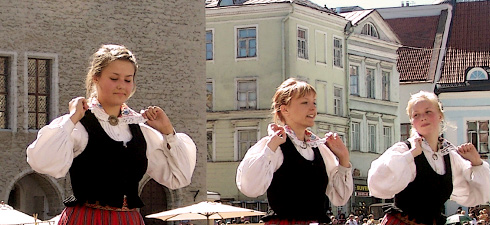A few weeks ago, I visited Vilnius, to get acquainted with this "Europos kulturos sostine", as Lithuanians might put it. In others words, with the European Capital of Culture 2009 [shared with Linz, in Austria], a distinction that will go to Tallinn in 2011 [and Turku, in Finland].
What Lithuanians have done for their capital is truly impressive. A book about various city squares in Vilnius (bilingual at that, in Lithuanian and English), modern sculptures along the banks of the river, movie and music festivals, street parties galore and an exhibition on Cold War design – to name just a handful of the current goings-on there. The numerous beneficiaries of the Capital of Culture 2009 title include various local companies: hotels and restaurants, but also local clothing manufacturers, which will be reaping windfalls from all the publicity they’ve been getting to promote this year’s Cultural Capital festivities in Vilnius.
Vilnius hopes to receive some three million tourists, and that of the 100-odd artistic and social projects developed for the occasion, at least three or four are there to stay. The budget for the whole programme comes to about €9 million (60% of which is funded by the Lithuanian State and 40% by the City of Vilnius), plus another €5 million in subsidies from the European Commission and €3 million from private sponsors.
So what about Tallinn, soon to be a European Capital of Culture in 2011? The only news we’ve been hearing constantly from the Estonian capital is of money troubles. Two years ago, the municipality decided to spend 189.64 million crowns [€12.12 million] over the period 2008–2012. But now it wants to scale the budget down by a third. The national government’s contribution has been very modest, moreover, at a mere 10 million crowns [€640,000].
Yes, money is probably not the crux of the matter: more essential is a vision – which Vilnius had. Last month Tallinn’s vision could still be easily encompassed within the space of a page and half, and what trickled down to the public was just a vague concept revolving around some “sea shore stories”, extolled as a “brilliant theme”.
But if Estonia proves incapable of capitalising on its stint as European Capital to promote its own culture throughout Europe, we will all lose out. And this opportunity won’t come round again for at least another ten years.
So the budget for the Capital of Culture project is to be cut by 10 million crowns. At the same time, though, Tallinn is planning to spend 30 million crowns on its television broadcasts next year. The Freedom Monument [an Estonian “Statue of Liberty”] (to be inaugurated soon) will cost upwards of 100 million crowns. In other words, Estonia is supporting projects under the control of the City or National Government, but is afraid of what is new and unknown.
Was this article useful? If so we are delighted!
It is freely available because we believe that the right to free and independent information is essential for democracy. But this right is not guaranteed forever, and independence comes at a cost. We need your support in order to continue publishing independent, multilingual news for all Europeans.
Discover our subscription offers and their exclusive benefits and become a member of our community now!












